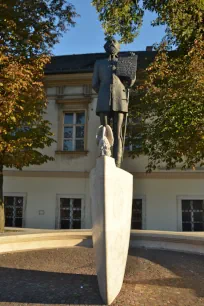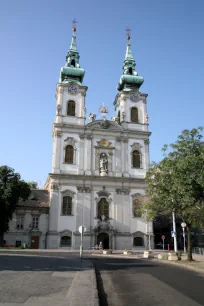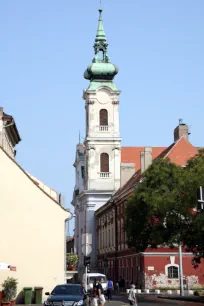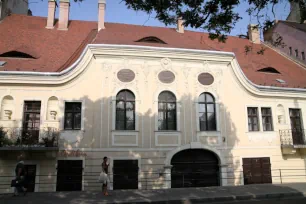The lively Batthyány Square is the former market square of Víziváros (Water city), a neighborhood squeezed between Castle Hill and the Danube river. The square has some interesting sights, including a Baroque church and an old market hall.
The square also borders the Danube embankment, which offers fantastic views of Pest and the Parliament Building in particular.



Lajos Batthyány
The square was originally known as ‘main market square’. Later it became known as bomb square (for an ammunition depot that was located here). In 1905, it was named after count Lajos Batthyány, who was prime minister of Hungary during the failed revolt against the Austrian Empire in 1848. He was executed the following year by the Austrian army.
Sights
Lajos Batthyány Statue
On the south side of Batthyány Square stands a monument honoring Lajos Batthyány. After an inauguration ceremony in 2007, it was installed here one year late, in 2008, to commemmorate the 200th birthday of Batthyány. The statue was created by sculptor Géza Stremeny, who records the moment Batthyány presents the April Laws of 1848, which were meant to give Hungary more sovereignty. The statue stands on a marble pedestal created in the shape of a ship’s hull. On its bow is a sculpture of a pelican feeding its young with her own blood, symbol of the Batthyany family.
Church of St. Anne
One of the main sights at Batthyány Square is the Church of St. Anne (Szent Anna templom), one of the most beautiful Baroque churches in Budapest. The Jesuits started with the construction of the church in 1740. By the time the church was finally consecrated in 1805, the Jesuit order had already been abolished. The interior is sumptuously decorated in the Baroque style.
Highlights include the high altar, adorned with marble sculptures, the ceiling frescoes and the pulpit, which features gilded reliefs. Unfortunately, the church is only open during services.
Monastery and Church of St. Francis
The north side of Batthyány Square is bordered by a large red building, the former convent of the St. Elisabeth nuns. The convent’s church, dedicated to Saint Francis, has a sumptuous Baroque interior. In front of the convent stands the statue of Ferenc Kölcsey, a Hungarian poet best known as the author of the national anthem of Hungary.
White Cross Inn

To the west, Batthyány Square is bordered by the former White Cross Inn (Fehér Kereszt fogadó), a Rococo-style house that was formed in the late eighteenth century by combining two adjoining houses into a single building.
It was one of the first inns in Budapest, and it has reportedly received some notable guests, including Emperor Joseph II and the legendary womanizer Giacomo Casanova. The story goes that Casanova, who stayed here to recuperate from illness in the nearby Rác baths, seduced a local girl. The girl’s father, a butcher, wasn’t too happy with the affair and, with a butcher’s knife in his hand, scared Casanova out of the city.

Hirsch-House
Next door, at Batthyány Square no. 3, is another interesting building, the Hirsch-House. Its late eighteenth-century facade in Louis XVI style is decorated with reliefs symbolizing the four seasons, hence it is also known as the Four Seasons House (Négy évszak ház). Like its neighbor, the building is well below the ground level of the square; in the nineteenth century, the ground level was raised to prevent frequent flooding of the area.
Market Hall
Also on the west side of the square is the oldest covered market hall in Buda, originally built in 1902 after a design by Pál Klunzinger. The brick building with a steel frame was destroyed during the Second World War, but later rebuilt. Today it is home to a supermarket.

